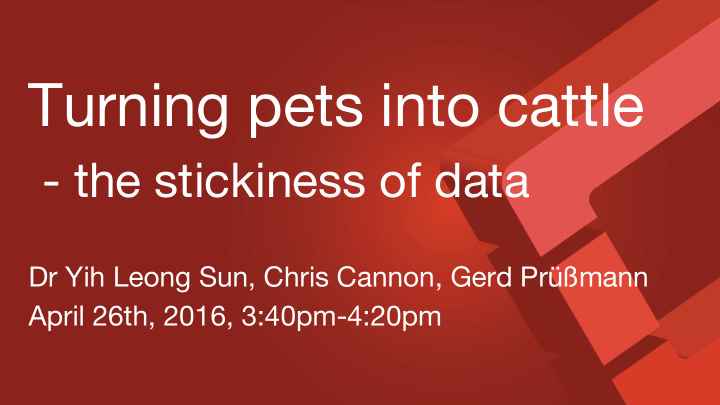



Turning pets into cattle - the stickiness of data Dr Yih Leong Sun, Chris Cannon, Gerd Prüßmann April 26th, 2016, 3:40pm-4:20pm
Introduction Dr Yih Leong Sun Chris Cannon Gerd Prüßmann Senior Cloud Architect Cloud Engineering Manager Director Cloud Solutions Intel Hewlett Packard Enterprise Mirantis Reference: https://wiki.openstack.org/wiki/Enterprise_Working_Group
What is this session NOT about? Continuous Integration and Continuous Deployment Automation Techniques for Infrastructure, Deployment, and Operations Agile Development Practices It’s an application architecture discussion
Agenda • Recap of previous presentation • The stickiness of data – Data challenges – Strategies • Q & A
Previous presentation
Pets vs Cattle Reference: https://www.openstack.org/assets/Uploads/presentation-turning-pets-into-cattle.pdf https://www.openstack.org/summit/tokyo-2015/videos/presentation/turning-pets-into-cattle-a-demonstration-to-provoke-discussion
Virtualization vs Cloud Reference: http://www.openstack.org/assets/pdf-downloads/business-perspectives.pdf
Architecture design Conventional App Cloud-aware App ● Monolithic ● Distributed ● Centralised state ● Microservices ● Tightly coupled ● Asynchronous vs ● Synchronous ● Multi-tenancy ● Single tenancy ● Failure-resilience ● Share-nothing ● Eventually consistent Reference: http://www.opendatacenteralliance.org/docs/architecting_cloud_aware_applications.pdf
Multiple strategies VM w1 VM Web Web w2 static Web w1 a1 VM VM content App App a2 a1 App VM VM DB DB
Data stickiness
Data challenges • Every Pet is different • Challenges of existing data – How to migrate existing data to the cloud? Data migration: file copying, hot/cold export, machine copying, • continuous replication … Integrity, consistency, licensing & down time • – Data virtualization • SLA (policies, performance, RTO, RPO, etc ...) • What is your current situation and limitation?
Data strategies
Option 1 - No change to backend data store • Lower migration risk by using existing DB deployments • Most PaaS systems can connect to legacy DB environments • Continue to leverage capabilities that may not be fully available in cloud-based DB today
Option 2 - ‘Cloudifying’ RDBMS / Example Pros • Known technology / operational tasks • Leverages DB scalability Cons Limitations / reqs to the schema • Not all engines available • • Operational tasks remain • Automation efforts *Other names and brands may be claimed as the property of others.
Option 2 - ‘Cloudifying’ RDBMS / Trove Openstack DBaaS project • offering self-service provisioning functionality for RDBMS and non-RDBMS easy on-demand DB • consumption multiple DB instances per user • resource isolation • task automation for • deployment, config, patching etc. Cassandra, CouchBase, CouchDB, DataStax Enterprise, DB2, MariaDB, MongoDB, MySQL, Oracle, Percona Server, PostgreSQL, Redis and Vertica
Option 2 - ‘Cloudifying’ RDBMS / Trove Key Features Capability Client Database General Purpose (SSD) Storage Yes - Relies on OpenStack Cinder storage capability Performance Provisioned IOPS (SSD) Storage Yes - Relies on OpenStack Cinder storage capability Push-button Compute Scaling Limited - Requires manual expansion Scalability Easy Storage Scaling Limited - Requires migration to new database Automated Backups Limited- Requires external backup solution Database Snapshots Limited - Requires external backup solution Yes - Limited to a single OpenStack environment. No option to specify Multi-AZ Deployments specific AZ. DR with Multi-Site/multi-Region Deployment No Availability and Durability Automatic Host Replacement No Encryption at Rest and In Transit Limited Network Isolation Yes Security Resource-level Permissions Yes Monitoring and Metrics No - Requires external monitoring solution. No SLA calculation. Automatic Software Patching No - Requires external patching solution Manageability DB Event Notifications No - Requires external notification solution Metering Collect usage metrics for billing No current usage metrics are emitted by Trove
Example: WordPress* Use alternative ‘cloud-native’ DB backends for WordPress ? • Official WordPress supports MySQL* / MariaDB* engines only – PostgreSQL* ongoing – NoSQL backend not planned – Codebase: MySQL centric • Approaches: • Status Quo: Development for MySQL only – Fork necessary for every new database type (costly for porting) • WordPress specific database abstraction layer – Full database abstraction layer – *Other names and brands may be Reference: https://codex.wordpress.org/Using_Alternative_Databases claimed as the property of others.
Option 3 - RDBMS to NoSQL • Why should I migrate from RDBMS to NoSQL? Database Example Use Case NoSQL Cassandra*, IoT, BigData, MongoDB* Widely distributed architecture unstructured data RDBMS MySQL*, MSSQL* OLAP, OLTP, ACID, structured data *Other names and brands may be Reference: https://www.mongodb.com/collateral/rdbms-mongodb-migration-guide claimed as the property of others.
Option 3 - RDBMS to NoSQL • Migration tactics – Build your own scripts, ETL, Hadoop – Snapshot and incremental – Application-driven • Keeping data in both RDBMS & NoSQL concurrently during transition period • On-demand
Summary Understanding your Pets • Some existing database technologies are not designed for Cloud • Differences in design principle between RDBMS & NoSQL • Transformation from existing environment to Cloud ‘culture’ • Skillsets and training for Ops and Dev •
Q & A
OpenStack Enterprise Working Group JOIN US! Objective: • To identify and remove barriers to Enterprise adoption and deployment of OpenStack*. Mailing List: • http://lists.openstack.org/cgi-bin/mailman/listinfo/enterprise-wg Meeting Logistics: • Thursday 1700 UTC Call In Info: (888) 875-9370, Bridge: 3; Passcode: 9518007# *Other names and brands may be claimed as the property of others.
Thank you yih.leong.sun@intel.com ccannon@hpe.com gpruessmann@mirantis.com
Legal Disclaimer OpenStack is a registered trademark of the OpenStack Foundation in the United States, other countries or both. Intel and the Intel logo are trademarks of Intel Corporation in the U.S. and/or other countries. Mirantis, and the Mirantis Logo are registered trademarks that belong to Mirantis Inc.
Recommend
More recommend